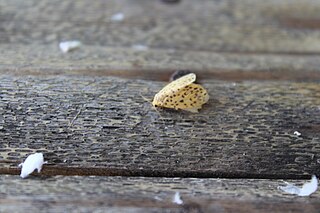
Florida is a state located in the southeastern region of the United States. With a population of over 21 million, Florida is the third-most populous and the 22nd-most extensive of the 50 United States. The state is bordered to the west by the Gulf of Mexico, to the northwest by Alabama, to the north by Georgia, to the east by the Atlantic Ocean, and to the south by the Straits of Florida. The state's capital is Tallahassee and its most populous municipality is Jacksonville. The Miami metropolitan area, with a population of almost 6.2 million, is the most populous urban area in Florida and the seventh-most populous in the United States. Other urban areas in the state with a population of more than one million are Tampa Bay, Orlando, and Jacksonville. Florida's $1.0 trillion economy is the fourth-largest of any U.S. state, and if it were a country, Florida would be the 16th-largest economy in the world.
Hypsopygia nostralis, the southern hayworm moth, is a species of snout moth in the genus Hypsopygia. It was described by Achille Guenée in 1854. It has a wide distribution and is found in most of South America, Saint Helena, Réunion, Mauritius, Puerto Rico and in the southern United States, from Texas to Florida and Madagascar

Syngamia florella, the orange-spotted flower moth or red waisted florella moth, is a moth of the family Crambidae. It was described by Caspar Stoll in 1781. It is found from South Carolina to Florida and from Arkansas to Texas, south to the West Indies and through Mexico to Argentina. It is also found on Bermuda.
Trischistognatha pyrenealis is a moth in the family Crambidae. It was described by Francis Walker in 1859. It is found in Mexico, Central America, the West Indies and the southeastern United States, where it has been recorded from Georgia to Florida and from Alabama to Texas.

Pyrausta bicoloralis, the bicolored pyrausta moth, is a moth in the family Crambidae. It was described by Achille Guenée in 1854. It is found in North America, where it has been recorded from Nova Scotia south to Florida, west to Michigan and Texas. In the south, the range extends to South America.
Carectocultus perstrialis, the reed-boring crambid moth, is a moth in the family Crambidae. It was described by Jacob Hübner in 1831. It is found in North America, where it has been recorded from Florida, Georgia, Maryland, Massachusetts, Mississippi, Nova Scotia, Ohio, South Carolina and Texas. Outside of the United States, it has also been recorded from the West Indies and South America.
Agathodes designalis, the sky-pointing moth, is a moth in the family Crambidae. It was described by Achille Guenée in 1854. It is found from the southern United States, where it has been recorded from Arizona, Texas and Florida, south to southern South America. It is also found on the West Indies.
Cnaphalocrocis cochrusalis, the marasmia moth, is a moth in the family Crambidae. It is found in the West Indies, Costa Rica, Honduras and the United States, where it has been recorded from Florida, Louisiana, Mississippi, Oklahoma, South Carolina and Texas.
Desmia ploralis, the mournful desmia moth, is a moth in the family Crambidae. It was described by Achille Guenée in 1854. It is found in French Guiana, Suriname, Brazil, Guatemala, Costa Rica, Mexico, the Caribbean and Florida.
Diacme mopsalis, the mopsalis diacme moth, is a moth in the family Crambidae. It was described by Francis Walker in 1859. It is found in South America, Central America, the Antilles and the southern United States, where it has been recorded from Arizona, Florida, Oklahoma and Texas.

Diastictis argyralis, the white-spotted orange moth, is a moth in the family Crambidae. It was described by Jacob Hübner in 1818. It is found in North America, where it has been recorded from Colorado, Florida, Georgia, Indiana, Maine, Maryland, Mississippi, North Carolina, Ohio, Ontario, South Carolina, Tennessee, Texas and Virginia.
Ercta vittata is a moth in the family Crambidae. It was described by Johan Christian Fabricius in 1794. It is found in the West Indies and South America. It has also been recorded from Costa Rica and southern Florida.

Glyphodes pyloalis, the lesser mulberry snout moth, lesser mulberry pyralid or beautiful glyphodes moth, is a moth in the family Crambidae. It was described by Francis Walker in 1859. It is found in Iran, China, Japan, India, Indonesia (Sumatra), Sri Lanka, Taiwan, the Democratic Republic of the Congo, Equatorial Guinea, Mozambique and North America, where it has been recorded from Florida, Maryland, North Carolina, South Carolina and Virginia.
Glyphodes floridalis, the Florida milkweed vine moth, is a moth in the family Crambidae. It is found in North America, where it has been recorded from Florida.
Mecyna submedialis, the orange-toned mecyna moth, is a moth in the family Crambidae. It was described by Augustus Radcliffe Grote in 1876. It is found in North America, where it has been recorded from Ontario and Michigan, south to Florida and west to Arkansas. It has also been recorded from Alberta.
Microphysetica hermeasalis is a moth from the family Crambidae. The moth was discovered by Francis Walker in 1859, and it is found in Venezuela, Mexico, Central America, the Antilles and Florida. Its wingspan is 9–10 mm. Adults are on wing from March to June and from November to December in Florida.

Palpita flegia, the satin white moth, is a moth in the family Crambidae. It was described by Pieter Cramer in 1777. It is found in Suriname, Colombia, Brazil, Honduras, Nicaragua, Costa Rica, Panama, Mexico, the Caribbean and the United States, where it has been recorded from Alabama, Florida and Texas.
Penestola bufalis, the black penestola moth, is a moth in the family Crambidae. It was described by Achille Guenée in 1854. It is found in the US states of Texas and Florida, as well as on the Antilles. It is an accidentally introduced species on the Galápagos Islands. The habitat consists of coastal mangrove swamps and shorelines.

Polygrammodes eleuata, the red-spotted sweetpotato moth or many-spotted moth, is a moth in the family Crambidae. It was described by Johan Christian Fabricius in 1777. It is found in Central and South America, on the Antilles and in the southern United States, where it has been recorded from Florida.
Akito Y. Kawahara is an American and Japanese entomologist, scientist, and advocate of nature education.






